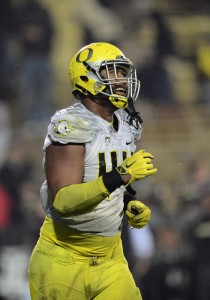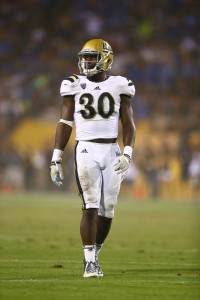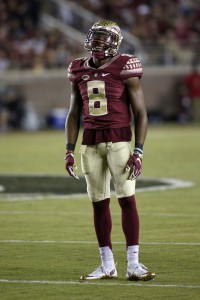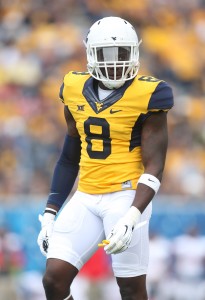The 2016 NFL draft is less than 24 hours away, and teams are looking for players capable of improving the long-term outlook of the franchise, while fans hope their favorite team’s next draft pick will be the star who brings the city one step closer to the postseason, or even a Super Bowl.
A handful of names have dominated the conversation in recent weeks, with most mock drafts (including ours) focusing on the first round. Over the last couple days, we’ve taken a closer look at several more day-two and day-three names, identifying the top 15 prospects at each position in the 2016 draft class.
We’ll almost certainly be higher or lower on some prospects than you are, so feel free to weigh in below in our comments section to let us know which players we’ve got wrong.
After getting to know some of this year’s top offensive prospects on Tuesday, here’s a breakdown of our picks for 2016’s top 15 prospects by defensive position:
Interior Defensive Line:
- DeForest Buckner (Oregon)

- Robert Nkemdiche (Ole Miss)
- Kenny Clark (UCLA)
- Andrew Billings (Baylor)
- A’Shawn Robinson (Alabama)
- Jarran Reed (Alabama)
- Sheldon Rankins (Louisville)
- Chris Jones (Mississippi State)
- Maliek Collins (Nebraska)
- Sheldon Day (Notre Dame)
- Austin Johnson (Penn State)
- Jihad Ward (Illinois)
- Vernon Butler (Louisiana Tech)
- Hassan Ridgeway (Texas)
- Adolphus Washington (Ohio State)
Among the deepest positions in this year’s draft, the interior defensive line class is loaded with talented players worthy of being selected on the first two days of the draft. DeForest Buckner is the premier player of the group, with a chance to be the first non-quarterback prospect selected this year. At 6’7″ and nearly 300 pounds, he developed a reputation as a mean run stopper during his first three years at Oregon. At this time last year, as Arik Armstead was preparing to be a top-15 selection in the 2015 NFL Draft, scouts and analysts were looking ahead and whispering that Buckner was already better than Armstead. And that was before he broke out to the tune of 17 tackles for a loss and 10.5 sacks, making Buckner not only an interior run stuffer with upside, but a legitimate pass rusher on the inside who can branch out as a 3-4 defensive end.
Physically the only player in Buckner’s class is Robert Nkemdiche. Formerly the nation’s number one recruit, Nkemdiche is an unbelievable athlete for his size and position. At 6’3″ and 294 pounds, he ran a blazing fast 4.86 40-yard dash, while also showing his explosiveness with a 35-inch vertical jump and his strength with 28 reps on the bench press. Looking at his highlight film, every bit of that athleticism and more is present, and at times he looks like a grizzly bear stuffed in a helmet and shoulder pads.
However, despite being in the conversation for the most talented player at his position, Nkemdiche might be considered lucky to remain in the first-round conversation at this point in the process. He has off-the-field red flags, mostly stemming from an incident in which he fell out of his hotel balcony, causing him to be suspended from a bowl game. Teams are also believed to be concerned about his older brother’s influence. Meanwhile, on the field, Nkemdiche’s production never lived up to his hype, and questions about his motor and work ethic have led some teams to be cautious while evaluating him.
Those two defensive tackles stand out, but there are plenty of young men in this group who will have a chance to become very good NFL players. Preference and scheme fit that will dictate draft order in many cases. Andrew Billings and Jarran Reed are prototypical nose tackles, but each has the athleticism to be more dominant than your run-of-the-mill space eater in the middle. Austin Johnson could be placed in the same boat, though he’s not quite as polished as the other two.
A’Shawn Robinson and Kenny Clark play a little differently — they’re both capable of disrupting plays by moving laterally as well as by getting upfield against the run and even the pass. Sheldon Rankins is a more prototypical three-technique who is best when he can fire off the ball and try to penetrate the offensive line.
Chris Jones and Maliek Collins are a little up and down because of inconsistent tape. Jones has moments of brilliance while coming up small at other times, while Collins flashed in 2014 and not as much in 2015. Sheldon Day and Vernon Butler present good run-stuffing options in the middle, and both could be available in round two due to the presence of all the other terrific options in this draft class. Jihad Ward and Hassan Ridgeway have the sort of athletic upside that has been enough to get guys drafted highly in the past, but as a part of this class they fall behind some of the more polished options.
Edge Defenders:
- Joey Bosa (Ohio State)

- Shaq Lawson (Clemson)
- Noah Spence (Eastern Kentucky)
- Emmanuel Ogbah (Oklahoma State)
- Jonathan Bullard (Florida)
- Kevin Dodd (Clemson)
- Leonard Floyd (Georgia)
- Shilique Calhoun (Michigan State)
- Kamalei Correa (Boise State)
- Yannick Ngakoue (Maryland)
- Carl Nassib (Penn State)
- Jordan Jenkins (Georgia)
- Aaron Wallace (UCLA)
- Bronson Kaufusi (BYU)
- James Cowser (Southern Utah)
The defensive end and pass-rushing outside linebacker positions aren’t quite as deep with budding talent as their interior brethren this year, but they’re no worse at the top. Buckner vs. Joey Bosa has been an ongoing debate this offseason. Unlike the argument over the top two quarterback prospects, the point is mostly moot because Buckner and Bosa play with such different styles and best fit different schemes. Bosa is a prototypical 4-3 defensive end, and has the production to back that up, with 51 tackles for a loss and 26 career sacks as a Buckeye. He has the speed, size, and strength to make a name for himself as a pass rusher, while also being disciplined and balanced enough to be one of the best run defenders in the game off the edge.
Shaq Lawson isn’t necessarily as physically dominant as Bosa, but his value stems from a lot of the same positive traits. Lawson was extremely balanced at Clemson, able to come away with 24.5 tackles for a loss and 12.5 sacks as a junior. His leadership on the defensive line helped drive the Tigers all the way to the National Championship Game. At the NFL combine, he showed that, in addition to having the skill and technique, he has the measurables and athleticism to make a move to 3-4 outside linebacker if he has to. It wouldn’t be a natural transition overnight, but it would likely go smoother for Lawson than for Bosa.
Noah Spence isn’t the balanced player that the top two edge prospects are, and neither is Emmanuel Ogbah. While neither is a disaster against the run, both look to make their living off getting after the quarterback. And both were remarkably productive doing so, with Ogbah bringing down the quarterback 26.5 times at Oklahoma State, while Spence recorded 7.5 sacks at Ohio State as a sophomore before transferring to Eastern Kentucky and adding 13.5 more in 2015.
Among the true pass rushers, Leonard Floyd, Shilique Calhoun, Kevin Dodd, and Kamalei Correa make up the next group on our list. Floyd was a starter at Georgia who has the physical traits, but never developed into the star pass rusher he was expected to become. Although he could climb in the draft on potential, he never had more than 6.5 sacks in a season for the Bulldogs. Dodd, meanwhile, basically had only one season – and to be more honest, one stretch of games – where he was a productive pass rusher. A lot of that comes from playing behind Lawson and Vic Beasley early in his career, but it’s a concern for someone who could be drafted so highly.
Calhoun was a good but undersized defensive end for Michigan State, and there are questions about whether he will be able to keep it up against better competition, while Correa has developmental upside as well as the versatility to rush the quarterback from a variety of positions along the front seven, from defensive end to middle linebacker.
Other highly rated guys like Jonathan Bullard, Jordan Jenkins, and Bronson Kaufisi may never end up being double-digit sack players in the NFL, but they all bring a combination of skills to make up for missing the one stat everyone wants on the defensive line. Bullard particularly is just a rock on the line, able to play inside or on the end on both sides of the formation and maintain integrity on the edge. Jenkins is an all-around linebacker type who should be able to find a niche as a two-down linebacker if he isn’t able to get consistent pressure at the next level. And while Kaufisi will have upside as a pass rusher – particularly as a 3-4 defensive end – he should be able to hold his own in the trenches as a run defender.
Linebacker:
- Myles Jack (UCLA)

- Darron Lee (Ohio State)
- Jaylon Smith (Notre Dame)
- Reggie Ragland (Alabama)
- Su’a Cravens (USC)
- Joshua Perry (Ohio State)
- Deion Jones (LSU)
- Kentrell Brothers (Missouri)
- Scooby Wright (Arizona)
- Eric Striker (Oklahoma)
- Antonio Morrison (Florida)
- Dominique Alexander (Oklahoma)
- Joe Schobert (Wisconsin)
- Tyler Matakevich (Temple)
- Cassanova McKinzy (Auburn)
The three players at the top of this ranking represent the change that is happening at the linebacker position in the NFL. Two of the three didn’t run a 40-yard dash due to knee injuries, and they may be slightly undersized as a group, but they possess the sort of speed, coverage skills, and dynamic play-making ability that defensive coordinators covet.
Myles Jack and Jaylon Smith were the real gems, before injuries negatively impacted their respective outlooks. Smith’s knee issue seems to be much more serious and will likely sideline him for the entire 2016 season, moving him out of round one, but his speed and physicality had some experts viewing him as the best player in the entire draft class during the season. Although he lined up mostly in the middle at Notre Dame, he was also prepped for a role as a pure pass rusher, which would be an added skill he could utilize if and when he returns to form.
Jack’s knee has some teams concerned about his long-term future, but plenty of clubs still appear comfortable with the idea of drafting him, and it would be a surprise if he falls out of the top 10 picks. He’s an impressive physical specimen, starring as a linebacker and running back at UCLA. Although Jack is set on playing defense in the NFL, some teams view him as a safety because of his elite physical skills. Given all that athleticism, he projects to be one of the best coverage linebackers in the NFL, able to run with running backs and even receivers, while possessing the necessary strength to deal with tight ends.
Darron Lee isn’t quite the athlete Jack is, but he’s not far off. He has no injury issues, and his impressive NFL combine numbers have put him in the conversation as a top-15 pick. He can run sideline to sideline to sniff out run plays and screens to the edge, and his acceleration to get into the backfield as a run stopper – or even to pressure the quarterback – makes him an excellent weapon to have on a defense.
The classic linebackers in the class are Reggie Ragland, Joshua Perry, and Kentrell Brothers. Ragland is a big man who can handle the middle of the field in the trenches, and also has experience on the defensive line as a pass rusher. He moves well laterally for his size, and while he doesn’t have the upside in coverage of the top guys, he does show good instincts particularly when dropping into a zone. Perry comes from the same mold, though he isn’t quite as instinctive in coverage, even if he’s more athletic in drills than expected. His value is way up for teams who think he can be a three-down linebacker. Brothers is another tackling machine, but he’s a little smaller and would be better as an outside linebacker if speed and quickness weren’t an issue.
Su’a Cravens and Deion Jones go the other way — they’re new age in the sense that they’re tweener safety/linebackers, but their ability to hold up against the run and take on blocks isn’t as proven. Cravens could be suited for a role like Deone Bucannon has for the Cardinals, but both of these prospects would be great athletes at weakside linebacker in a 4-3 with the ability to cover a huge area of grass to the sideline.
Cornerback:
- Jalen Ramsey (Florida State)

- Vernon Hargreaves III (Florida)
- Mackensie Alexander (Clemson)
- Eli Apple (Ohio State)
- William Jackson III (Houston)
- Artie Burns (Miami)
- KeiVarae Russell (Notre Dame)
- Will Redmond (Mississippi State)
- Xavien Howard (Baylor)
- Kendall Fuller (Virginia Tech)
- Kalan Reed (Southern Miss)
- Cyrus Jones (Alabama)
- Kevin Peterson (Oklahoma State)
- Zack Sanchez (Oklahoma)
- Harlan Miller (Southeastern Louisiana)
Despite spending a good portion of his collegiate career as a standout safety for the Seminoles, Jalen Ramsey will get his first shot in the NFL at corner. As a sophomore, he was being compared to dynamic playmakers like Eric Berry, and he has brought a lot of that physicality to the edges of the defense. Ramsey is a very good tackler with great athleticism and cover skills that make it difficult to find big plays in his half of the field. If forced to criticize Ramsey, analysts and scouts might say they wish he managed to grab a few more interceptions, but that’s a small nitpick when considering the overall package.
After Ramsey, Vernon Hargreaves III and Mackensie Alexander are considered two of the better cover corners available. They both did a great job sticking with receivers, despite being undersized. Hargreaves showed great instincts making plays on the football, intercepting 10 passes in three seasons for Florida. Alexander didn’t record a single interception in his two seasons at Clemson, which has caused many to be concerned about his ball skills. However, his success in coverage could be enough to land him in round one anyway.
William Jackson III and Eli Apple are the more physically impressive players, along with Xavien Howard and Artie Burns. All four players have ideal height and strength for the position, to go along with great speed and raw skills. Their tape tends to be a little bit inconsistent, but the potential is certainly there.
There are some smaller players in this group with potential as well. Kendall Fuller and KeiVarae Russell could each have been in the discussion as potential first-round picks if injuries had not derailed their 2015 seasons. Both players showed the cover skills to change offensive gameplans when they were on the field. Kalan Reed, Cyrus Jones, and even Will Redmond have a lot of versatility and toughness, despite not having a ton of size, and could impact the game covering in the slot as rookies.
Safety:
- Karl Joseph (West Virginia)

- Keanu Neal (Florida)
- Vonn Bell (Ohio State)
- T.J. Green (Clemson)
- Darian Thompson (Boise State)
- Jalen Mills (LSU)
- Tyvis Powell (Ohio State)
- Justin Simmons (Boston College)
- Jeremy Cash (Duke)
- Jayron Kearse (Clemson)
- Deon Bush (Miami)
- Miles Killebrew (Southern Utah)
- DeAndre Houston-Carson (William and Mary)
- Kevin Byard (Middle Tennessee)
- Sean Davis (Maryland)
With Ramsey nominally a corner, that opens the door for a wide open competition at the top of the safety board. Karl Joseph likely would have separated himself from the pack had he not missed most of the season after suffering a non-contact injury in practice. He is a violent tackler with great speed and the ball skills to flip the field in a hurry.
After Joseph, safeties two through nine are all grouped pretty closely, depending on preferences, with Keanu Neal and Vonn Bell having received the most first-round buzz. Neal has the ideal size and ability in coverage, and emerged as a better tackler in 2015 with the ability to play a deep zone or in the box. Bell isn’t as strong a tackler, but covers extremely well close to the line of scrimmage with the talent to do so from center field as well. He may not be a big hitter, but could play multiple roles on a defense, including covering slot receivers, which will likely be an assignment he draws early in his career.
Darian Thompson‘s first-round chances seem slimmer than they were when the college season ended, as he was lauded for his ability as a playmaker and his nose for the football. He may not have as much true speed as he showed on film, but his total of 17 interceptions in four years is bound to intrigue scouts and general managers.
T.J. Green and Jayron Kearse teamed up to form a ridiculously athletic pairing in the defensive backfield at Clemson, making up for whatever athletic shortcomings Alexander is perceived to have. Green stands at 6’2″, 205 pounds and managed 95 total tackles in 2015. He did that as a free safety, one that ran a blazing 4.34 40-yard dash. Kearse is even bigger, at nearly 6’5″ and 220 pounds, and while he didn’t run as well, he was part of the heart of the Clemson defense. Both players are knocked for their all-around games, with Kearse struggling in coverage and Green not moving as fluidly as his timed speed, but there will be NFL roles for both guys. Green, in particular, has the potential to move to corner at the next level, where he could be an ideal cover-3 corner in the mold of Richard Sherman in Seattle.
Jeremy Cash and Justin Simmons are big hitters with a few more natural safety attributes. They both could find themselves playing hybrid roles in the NFL — there’s a chance that Cash could eventually be used better as a weakside linebacker. Both made it through college as solid coverage options, but playing center field against NFL talent may be a stretch.
Jalen Mills and Tyvis Powell might be more suited to those roles, as both have good instincts in coverage and Mills has especially good ball skills, even if that didn’t translate to a huge amount of interceptions in college. Powell’s height and speed are similar to Green’s, and while Powell is more comfortable as a safety than Green sometimes looks, it wouldn’t be surprising for a team to use Powell in multiple positions in the defensive backfield.
Photos courtesy of USA Today Sports Images.
Adolphus Washington should be in the bottom of the Top Ten! He dominated the Big Ten o-lines this year and has gotten better each year. I am glad you have Kenny Clark as high as you do…he is a very good player with a high motor who may be a better pro than he was a college player.
What I meant to say is Adolphus should be rated 9th or 10th…not 15th.
Might be the lowest I’ve seen Sheldon Rankins ranked. He’s likely to go top 20, possibly top 15.
They’re just wrong about that one. Adolphus Washington should be 9 on that list too with the 9-14 guys moving down a spot each. (not that they are ranked perfectly in order). Sorry to give you pfr guys a hard time but the “Washington” thing makes me less sorry, just since I’m a lifelong redskin fan.